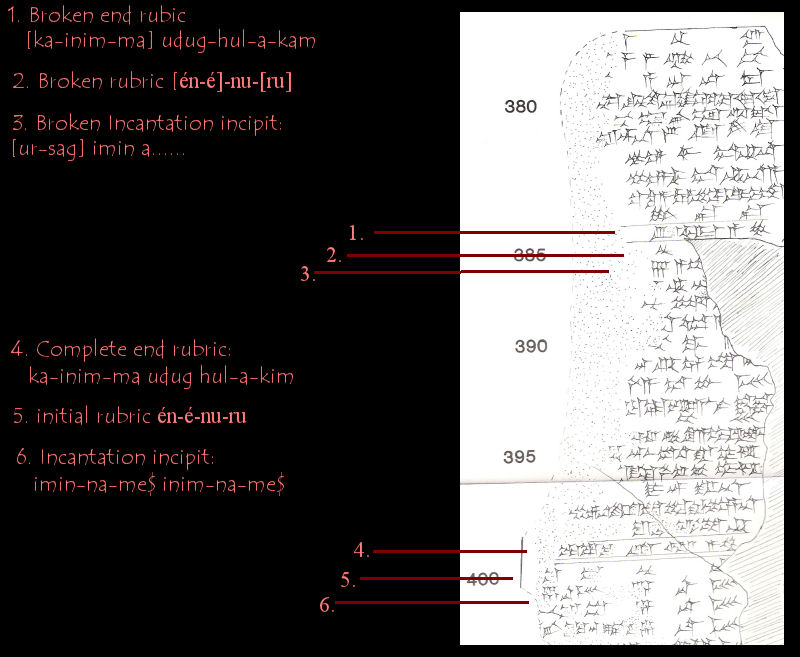
What is an Incantation?
W.G.
Lambert (1) tell us that an incantation
is a text to be recited which brings magic power to bear, usually
when recited with observation of some rite or rites. It unlocks
a certain power in the universe which the person reciting either
wants or needs.
How is an incantation identifiable in Cuneiform texts?
(What is en2-e2-nu-ru
(LAK358 + nu + ru (phonetic indicators))?
Lambert states that in Mesopotamian incantation texts, there
is a "Classical" formula prefixed to incantations which specifies
their category, the formula is: én-e-nu-ru. It is omni-present
in Early Dynastic period (with orthographic variations), and
carried over to the Akkadian and Ur III periods (in the latter,
it is occasionally lacking and, rarely, is placed at then end
of a piece.) He states: "In copies of incantations from the
second and third millennia it is not so frequent but can also
occur at the end as well as at the beginning. More commonly,
indeed very regularly, én alone is written at the beginnings
of incantations in copies of these two millennia. The sign means
of course "incantation," but so far we do not know the meaning
of é-nu-ru, and it may be suspected that at least after Early
Dynastic times the ancients did not know either. Hence the frequent
use [in later texts] of én alone."
It's use as
an initial rubric to identify an incantation incipit
(en2-e2-nu-ru in practice)
I refer below to M.J. Geller (2),
who gives us some explanation of the way the formula en2-e2-nu-ru
was used as an initial rubric (it came before the incipit, the
'title' of an incantation, and alerted the reader about the
nature of the following material). Geller's remarks here are
most relevant to incantations in the Old Babylonian period:
"The difficulty of keeping track of incantations within complex
compositions was as acute for the ancient scholar as the for
modern one, and steps were taken to record the state of incantation
texts. Fortunately, labels could be relied upon to help keep
track of textual components. The typical Old Babylonian (and
earlier) rubric of én-é-nu-ru was usually abbreviated to én,
which was used to identify incantation incipits. Each individual
incantation normally ended with either a ruling, or with a [end]
rubric [that read] ka-inim-ma.... Incantations were then divided
into "tablets" (dub), which were labeled under a general rubric
giving the title of the incantation series. The system, however,
is not entirely satisfactory from the perspective of modern
scholarship. The label én was employed to indicate the incipit
of the opening incantation (and hence opening line) of an incantation
"tablet," by which the incantation tablet could be known. However,
én was also used to label every subsequent incantation incipit
within the tablet, and no method was used to distinguish between
the opening line of the tablet and the opening line of other
incantations within the tablet."
To illustrate what Geller is describing, I have created the
below image useing a plate from that author's 1986 book dealing
with Old Babylonian incantations.

To sum the use of the en2-e2-nu-ru formula as a initial rubric
in incantation texts then:
- In the incantation structure, first came the initial én-é-nu-ru
rubric which identified the line to follow as an incantation
incipit
- This second line is the incantation incipit itself, by which
also the incantation was known (like a title.)
- The body of the incantation followed
- The incantation text would end with either a ruling (a horizontal
line drawn across the tablet) or a second rubric reading ka-inim-ma
(also meaning incantation and often used as in 'incantation
of so and so'.)
1: In Proceedings of the 51st
Recontre Assyriologique internationale (2005), Lambert writes
on the subject in his contribution 'The Classification of Incantations'
(pg. 93.) Download it here.
2: In Wisdom, Gods and Literature:
Studies in Assyriology in Honour of W.G. Lambert, see Geller's
contribution titled 'Incipits and Rubrics'.